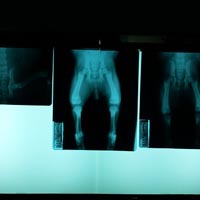Rehabilitative management of pelvic fractures needs to be further optimized

Accepted: 18 November 2021
HTML: 6
All claims expressed in this article are solely those of the authors and do not necessarily represent those of their affiliated organizations, or those of the publisher, the editors and the reviewers. Any product that may be evaluated in this article or claim that may be made by its manufacturer is not guaranteed or endorsed by the publisher.
We read with interest the review by Piccione et al. into the rehabilitative management of patients with pelvic fracture (PF). This review adds to our knowledge about the significance and indispensability of early multidisciplinary intervention in PF. From our perspective, however, potential bias might be caused by several unanswered questions. The uncertain methodological process and the unclear definition could misguide the rehabilitation strategies while still in dispute. Therefore, further high-quality studies should be conducted to optimize the multidisciplinary rehabilitation of patients with PF.
Piccione F, Maccarone MC, Cortese AM, Rocca G, Sansubrino U, Piran G, Masiero S. Rehabilitative management of pelvic fractures: a literature-based update. Eur J Transl Myol. 2021 Sep 17;31(3):9933. DOI: https://doi.org/10.4081/ejtm.2021.9933
Rickman M, Link BC, Solomon LB. Patient Weight-bearing after Pelvic Fracture Surgery-A Systematic Review of the Literature: What is the Modern Evidence Base? Strategies Trauma Limb Reconstr. 2019 Jan-Apr;14(1):45-52. DOI: https://doi.org/10.5005/jp-journals-10080-1414
Haller JM, Potter MQ, Kubiak EN. Weight bearing after a periarticular fracture: what is the evidence? Orthop Clin North Am. 2013 Oct;44(4):509-19. DOI: https://doi.org/10.1016/j.ocl.2013.06.005
Cornwall R, Gilbert MS, Koval KJ, Strauss E, Siu AL. Functional outcomes and mortality vary among different types of hip fractures: a function of patient characteristics. Clin Orthop Relat Res. 2004 Aug;(425):64-71. DOI: https://doi.org/10.1097/01.blo.0000132406.37763.b3
Meys G, Kalmet PHS, Sanduleanu S, van Horn YY, Maas GJ, Poeze M, Brink PRG, Seelen HAM. A protocol for permissive weight-bearing during allied health therapy in surgically treated fractures of the pelvis and lower extremities. J Rehabil Med. 2019 Apr 1;51(4):290-297. DOI: https://doi.org/10.2340/16501977-2532
PAGEPress has chosen to apply the Creative Commons Attribution NonCommercial 4.0 International License (CC BY-NC 4.0) to all manuscripts to be published.


 https://doi.org/10.4081/ejtm.2021.10246
https://doi.org/10.4081/ejtm.2021.10246



